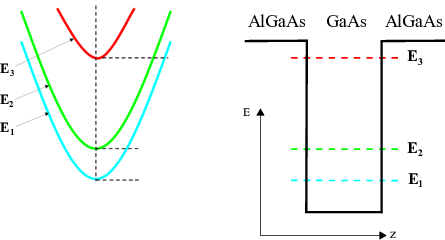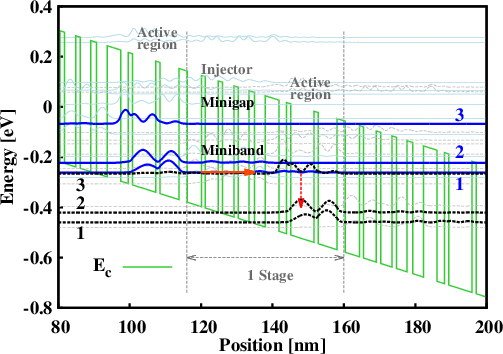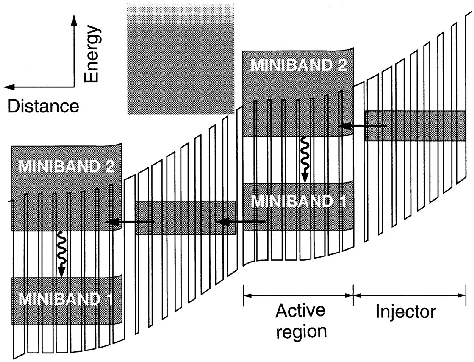
Before the invention of diode lasers, a semiconductor laser based on transitions between Landau levels in a strong magnetic field was proposed by Lax in 1960 [90]. This is the first proposal of a semiconductor laser in which the optical transition occurs between low dimensional states of the same band (conduction or valence) rather than by the recombination of electron-hole pairs across the semiconductor bandgap [91]. The idea of a unipolar laser was then ignored for many years because only 2 years after the proposal of Lax the first diode laser was demonstrated [92]. This exploit drew all the attention of the semiconductor community on bandgap lasers and began the race for the first diode laser continuous-wave (cw) operation at room temperature. The race ended in 1970 when this goal was reached by the first AlGaAs/GaAs heterostructure laser at nearly the same time by Alferov’s group at the Ioffe Institute in St. Petersburg [93] and by Panish et al. [94] at Bell Labs (Murray Hill, NJ).
The effort to improve the performance of diode lasers and the development of the transistor technology in III-V compounds had an enormous impact on the epitaxial growth techniques of thin semiconductor layers and gave rise to the concept of two-dimensional structures such as quantum wells (QWs) and inversion layers [95]. The confinement of carriers in semiconductor quantum wells and superlattices leads to formation of energy levels and subbands. Figure 2.7 shows the conduction band of a quantum well which splits into subbands.
In 1970, Esaki and Tsu [96] proposed the use of heterostructures for applications in optoelectronics. Kazarinov and Suris [97] were the first to propose intersubband transitions to design a laser. The quantum cascade laser (QCL) is a special kind of semiconductor laser, usually emitting mid-infrared light. Such a laser operates on laser transitions not between different electronic bands, but instead on intersubband transitions of a semiconductor structure. The first QCL was demonstrated by Federico Capasso in 1994 at Bell Labs for a wavelength of 4.2 μm, [98] and in 2001 Alessandro Tredicucci developed the first MIR QCL, operating at 68 μm [99]. QCLs have since then achieved significant performance improvements and are poised to become the dominant laser sources in the mid- and far-infrared spectral ranges. Lasing has been obtained at wavelengths ranging from 3.4-24 μm [98,100] in the mid-infrared and 60-161 μm in the far-infrared [101].

The general principles of QCL operation are illustrated in Fig. 2.8. Shown are two active regions, i.e. the quantum well and barrier regions that support the electronic states between which the laser transition is taking place, and schematically the intermediate injector region. We draw the conduction band edge of the InGaAs QWs and the AlInAs barriers using the 520 meV low-temperature conduction band-offset usually associated with the materials’ compositions (In0.53Ga0.47As, Al0.48In0.52As) lattice matched to the InP substrate. An external electric field is applied as visualized by the linear slope of the electronic potential. Solving the Schršodinger equation results in the energy levels drawn and the moduli squared of the wave functions. The wave functions and energy levels of each stage are shown. The lasing subbands are indicated with bold solid/bold dashed lines.

The QW thicknesses in the active region are selected such that the energy separation between level 3 and 2 corresponds to the desired wavelength. The energy separation between level 2 and 1 is deliberately chosen to be very close to the energy of the LO-phonon modes of the InGaAs/AlInAs/active region materials. Under an appropriate applied bias, electrons tunnel from the injector region into energy level 3, the upper laser state, of the active region. Electrons scatter from this level into both lower-lying levels 2 and 1, very rapidly emitting LO-phonons. The scattering time between levels 2, the lower laser state, and level 1 is ultra-short due to the resonant nature of this transition with the LO-phonon. Therefore, population inversion occurs between the laser levels 3 and 2 and laser action is possible. Electrons need only be supplied fast enough into level 3 by tunneling from the preceding injector region, and need to exit from levels 2 and more so from level 1 into the following downstream injector region at a high rate by tunneling. Inside the injector region and brought about by the externally applied electric field, electrons gain again in energy (relative to the band bottom) and are injected into the following downstream active region.
Typical QCLs have a cascade containing 20 to 30 active regions alternated with injector regions, although laser action has been achieved for a single active region [102], and has been tested for as many as 100 active regions [103]. A key feature of QCLs is the ability to cascade N modules together, so that a single injected electron can emit many photons, which allows for a differential quantum efficiency greater than unity.
In QCLs, three aspects mainly influence laser performance. First of all, optimization of the active region design, in order to ensure efficient carrier injection in the upper lasing state and carrier extraction out of the lower lasing state. Second, epitaxial growth optimization and third, optimization of the fabrication process, which is crucial to reduce optical losses and improve the laser thermal conductance [104]. Concerning the optimization of the laser design, many schemes have been proposed [105–107], however, a systematic study of the laser design was never permitted due to the large number of variables involved [104].
Since their inception in 1994 many designs of QCLs have emerged, and can basically be characterized by their number of QWs in the active region and the spatial extent and number of the wave functions in the active regions [108]. Three high-performance structures are introduced in the following.
The structure discussed in the last section (Fig. 2.8) is called a three-well (3QW) vertical-transition QCL in which a thin well is inserted between the injector region and an active region (which could also be termed a two-well vertical-transition active region). The additional QW leads to a significant reduction of electron scattering (leakage) from the injector directly into the laser ground state 2 and also level 1 [108]. The improvement led to the first high-performance, room temperature operation of QCLs [109]. This laser design, emitting at 8μm wavelength, provides high optical gain and concomitant robust laser action [110].
The active region, shown in Fig. 2.8, consists of three InGaAs QWs closely coupled by thin InAlAs barriers. At the appropriate electric field, corresponding to the measured laser threshold, the upper laser level (level 3) is separated from the lower laser level (level 2). The lower laser level is closely coupled to the ground state (level 1) of the active region, such that the two levels are strongly anti-crossed. This increases the matrix element z32 with respect to z31 and maximizes the scattering time between levels 3 and 2 with respect to the scattering time between levels 3 and 1. The energy difference between levels 2 and 1, designed to efficiently deplete the lower laser level of electrons via resonant LO-phonon scattering.
The injector ’miniband’ — more accurately, the manifold of energy levels in the injector — has been designed to be ’flat’. Its ground level is located below the upper laser level. Even the next-higher level of the injector miniband is energetically lower than the upper laser level. The injector has been doped in the center part. Therefore, at laser threshold, electrons are not injected from the Fermi-surface into the upper laser level. Furthermore level 1 of the preceding active region is in resonance with level 3 of the following active region, allowing for resonant carrier transport between successive active regions without significant carrier relaxation in the injector. In comparison, the relaxation time within the injector is long since the energy separation to the adjacent lower energy level is well below the LO-phonon energy and the ground level of the injector region is partly filled with electrons.
The 3QW vertical-transition design has this advantage that it avoids a too early ’shut-down’ of the laser due to suppression of resonant tunneling [111]. Once the electric field increases and the resonance between levels 1 and 3 is destroyed, there is still strong injection from the ground state of the injector, allowing for a wide dynamic range of current and concomitant high optical power [108]. The 3QW vertical-transition design is employed in the performance optimization and instability study presented in Sec. 6.2.
A different design of QCLs, which was first introduced in 1997, is the superlattice (SL) active region [112]. In short, laser action takes place between minibands, rather than between the subbands of few and single [113] well active region QCLs. High optical gain, large current carrying capabilities, and weaker temperature sensitivity are the advantages of SL-QCLs. However, they can generally only be applied for the longer-wavelength range (i.e. λ ≥ 7μm, for lattice-matched InP-based SL-QCLs) as the wider minibands take up more energy space than simple subbands [108].

In general, semiconductor SLs consist of a periodic stack of nanometer-thick layers of QWs and barriers. The period of this artificial crystal is typically much larger than the lattice constant of the bulk crystalline constituents. This superimposed periodic crystal potential splits the conduction band (and the valence bands as well) along the direction normal to the layers into a series of narrow (typically, tens to a few hundreds of meV wide) minibands separated by energy gaps (’minigaps’) in the strong-tunnel-coupling regime. For a given set of materials, miniband and minigap widths can be engineered by suitable choice of the layer thicknesses. In the generic case of the simple periodic SL, however, those widths are not independent of each other [108].
Figure 2.9 illustrates the original interminiband SL-QCL concept and its first realization [112]. Electrons are injected electrically from a preceding, equally doped, injector region directly into the ground state near the bottom of the second ’upper’ miniband, as was the case with the simple three-well active region discussed previously. From there, electrons can make an optical transition to the top of the lower miniband. In k-space, this transition occurs at the boundary of the mini-Brillouin-zone.
In QCLs, the inter-miniband scattering processes are generally dominated by LO-phonon emission. Specifically, an electron thermalized near the bottom of the higher miniband can relax down to states near the top of the lower miniband by scattering via LO-phonon emission employing a high momentum transfer. This process is characterized by a comparatively long scattering time of ~ 10 ps. Within each miniband, the electrons relax much faster — in a few tenths of a picosecond — by intra-miniband scattering, because it involves the emission of small-wavevector optical phonons. The resulting large ratio of relaxation times of inter- versus intra-miniband scattering events ensures an intrinsic population inversion across the minigap [108].
A second unique design feature of the SL-QCL is the high oscillator strength for the optical transition at the mini-Brillouin zone boundary of the SL. The oscillator strength of radiative transitions between the first two minibands of a SL increases with wavevector and is maximum at the zone boundary [114]. In particular, it strongly increases with decreasing barrier thickness. In the original SL-QCL structure shown in Fig. 2.9, the wavelength was selected as 8 μm, using an eight-period SL with 1 nm thick AlInAs barriers and 4.3 nm thick InGaAs QWs in lattice-matched composition. The structure was optimized for maximum oscillator strength with an optical dipole matrix element of 3.6 nm, i.e. approximately twice as large as that of similar-wavelength QCLs featuring few-well active regions.
The third type of active region we discuss here is called ’diagonal’ transitions active region in which the upper and lower state wave functions are clearly located in spatially different regions. The 3QW and SL-QCLs designs described in the previous two sections had in common that the wavefunctions directly involved in laser action, i.e. the upper and lower laser state, are essentially located in the same region of real space.
The two wave functions being collocated has several distinctive consequences. First, from an energy level point of view, the energy separation of the two states is largely independent of the applied electric field in a fairly wide range around the design field. This gives lasers based on such a vertical design a clear robustness in terms of wavelength versus applied voltage and, as a consequence, also versus temperature. On the other hand, and relating to the calculation of the gain coefficient, the collocation of the wave functions leads to a comparatively large optical dipole matrix element, but also comparatively short electron scattering times. Both are a result of the large overlap of the wave functions of upper and lower laser states [108].
In contrast to 3QW vertical transitions, QCLs based on such active regions show a strong dependence of the wavelength on the applied electric field through a voltage-induced Stark effect. The design parameters are furthermore characterized through a smaller dipole matrix element but also clearly longer scattering times, thus allowing again for sufficient gain to achieve laser action [108]. These lasers can operate up to room temperature and are exploited for large wavelength tunability [115]. This particular design can be used to fabricate QCLs that operate under both bias polarities and with nearly independent attributes, such as two different wavelengths [116] depending on bias polarity.
Ultrashort pulses with large instantaneous intensities from mode-locked lasers are key elements for many important applications such as time-resolved measurements [117,118], optical parametric generation [119], coherent control [120], four-wave mixing [121], and frequency combs [122].
The word mode-locking describes the locking of multiple axial modes in a laser cavity. By enforcing coherence between the phases of different modes, pulsed radiation can be produced. Mode-locking is a resonant phenomenon. By a relatively weak modulation synchronous with the roundtrip time of radiation circulating in the laser, a pulse is initiated and can be made shorter on every pass through the resonator. The shortening process continues unabated, until the pulse becomes so short and its spectrum so wide that pulse lengthening mechanisms or spectrum narrowing processes spring into action, such as finite bandwidth of the gain. The history of laser mode-locking is a progression of new and better ways to generate shorter and shorter pulses, and of improvements in the understanding of the mode-locking process.
To date, the most common approach to generate short pulses in the mid-infrared molecular ”fingerprint” region relies on the down-conversion of short-wavelength mode-locked lasers through nonlinear processes. These systems are usually bulky, expensive and typically require a complicated optical arrangement [123]. Design degrees of freedom in QCLs such as emission wavelength, gain spectrum [124], carrier transport characteristics, and optical dispersion make the QCL a unique candidate to serve as a semiconductor source of ultra-short pulses at MIR and THz domains. There is, however, an obstacle of fundamental origin that has so far prevented achieving ultrashort pulse generation in QCLs [125,126]. In intersubband transitions, the carrier relaxation is extremely fast because of optical phonon scattering. As a result, the gain recovery time in QCLs, determined both by upper state lifetime and by the electron transport through the cascade heterostructure, is typically on the order of a few picoseconds [127] which is an order of magnitude smaller than the cavity roundtrip time of 40-60 ps for a typical 2-3 mm-long laser cavity [123]. According to conventional mode-locking theory, this situation prevents the occurrence of stable passive mode-locking. However, under these conditions the elusive Risken-Nummedal-Graham-Haken (RNGH)-like instability can be possible in QCLs [125].
A saturable absorber is an optical component with a certain optical loss, which is reduced at high optical intensities. This can occur, e.g., in a medium with absorbing dopant ions, when a strong optical intensity leads to depletion of the ground state of these ions. Similar effects can occur in semiconductors, where excitation of electrons from the valence band into the conduction band reduces the absorption for photon energies just above the bandgap energy. The main applications of saturable absorbers are passive mode locking and Q switching of lasers, i.e., the generation of short pulses. However, saturable absorbers are also useful for purposes of nonlinear filtering outside laser resonators, e.g. for cleaning up pulse shapes, and in optical signal processing. In lasers with a relatively long gain recovery time compared to the cavity round-trip time, the instability caused by a saturable absorber (SA) can often lead to passive mode locking [128].
We investigate the passive mode locking with saturable absorber in QCLs operating at MIR and THz. The effects of saturable absorber and pumping strength on the instability characteristics are studied. A numerical calculation based on the Maxwell-Bloch equations is performed to analyze the dynamics of QCLs, see Sec. 6.3.